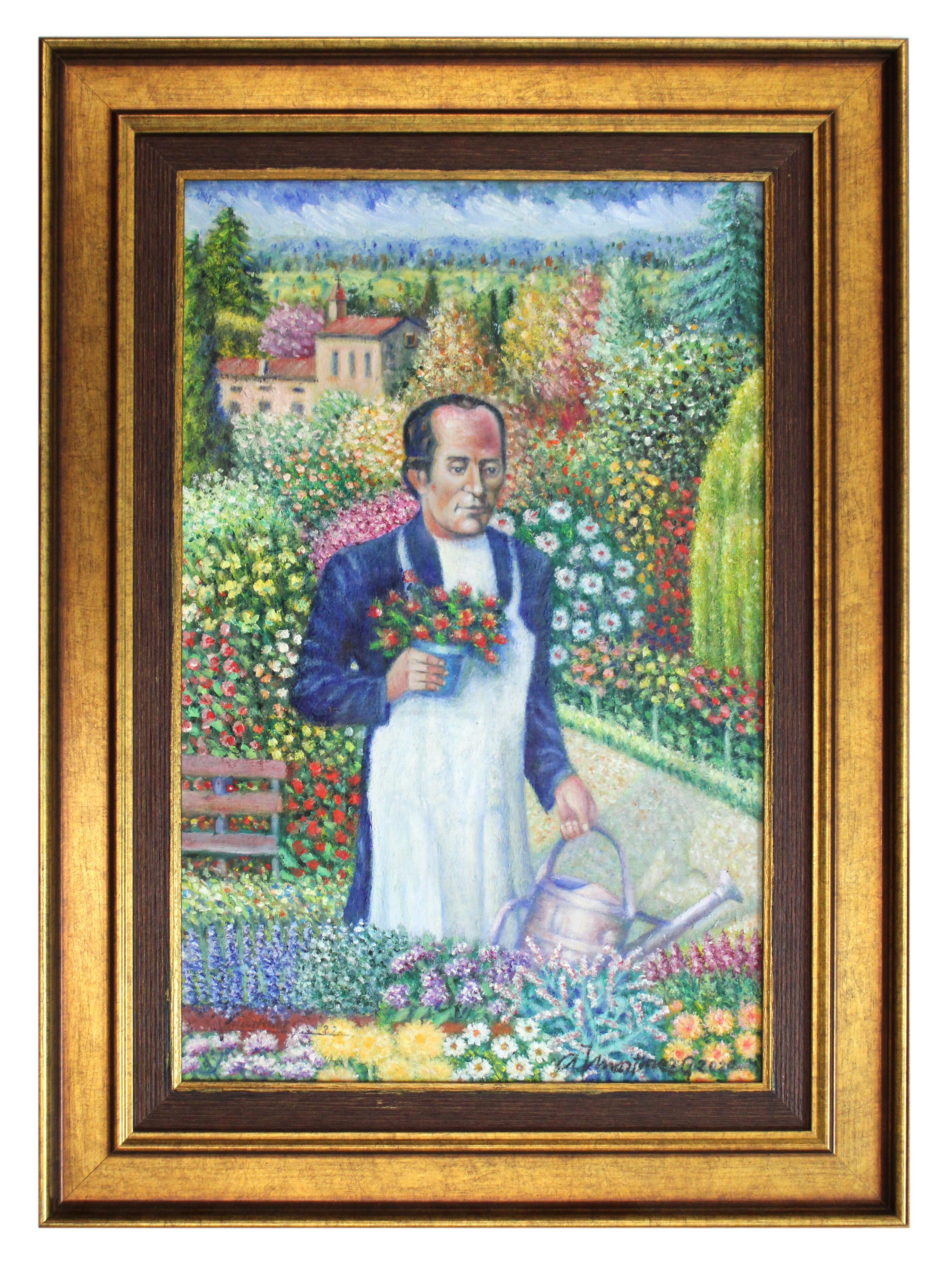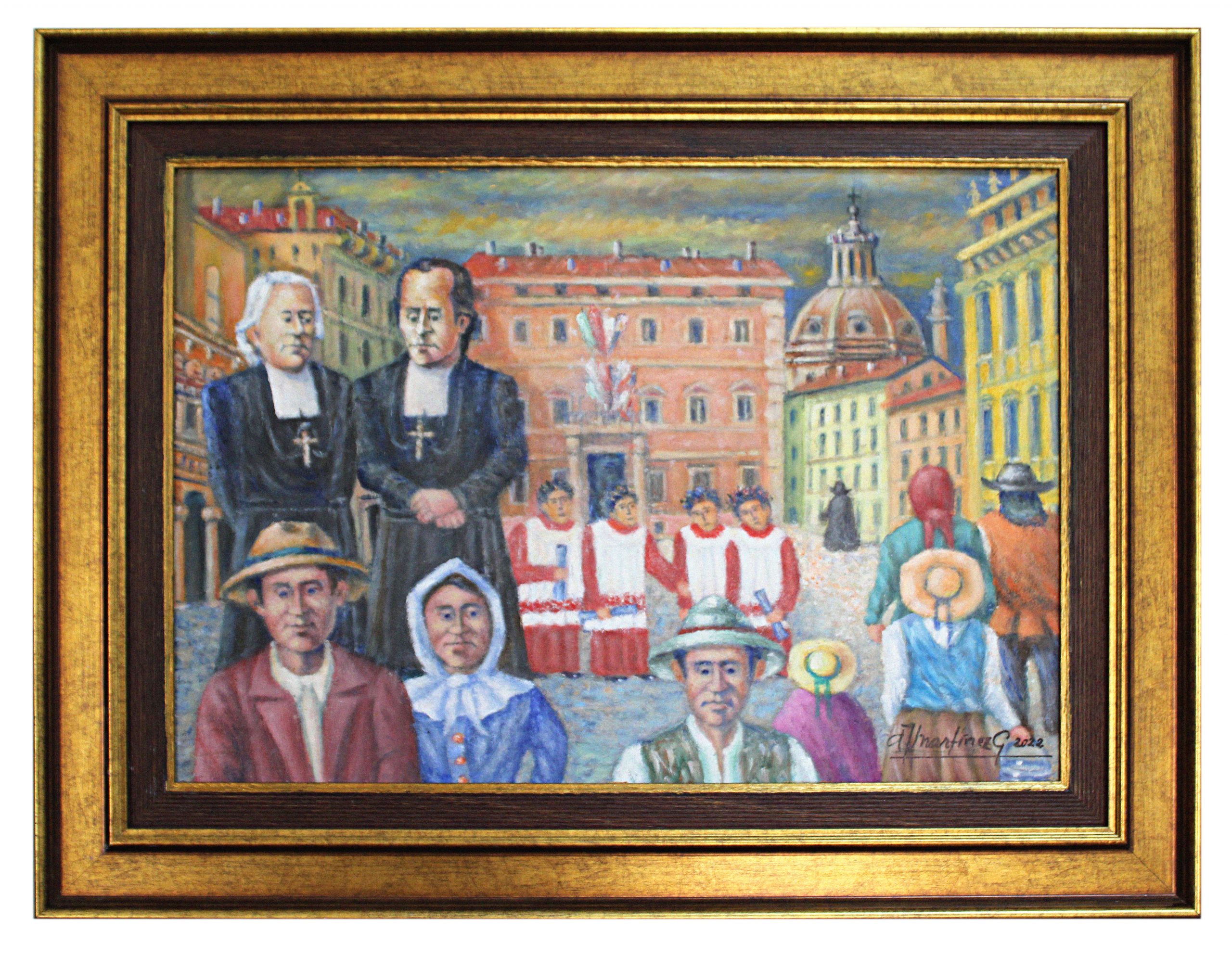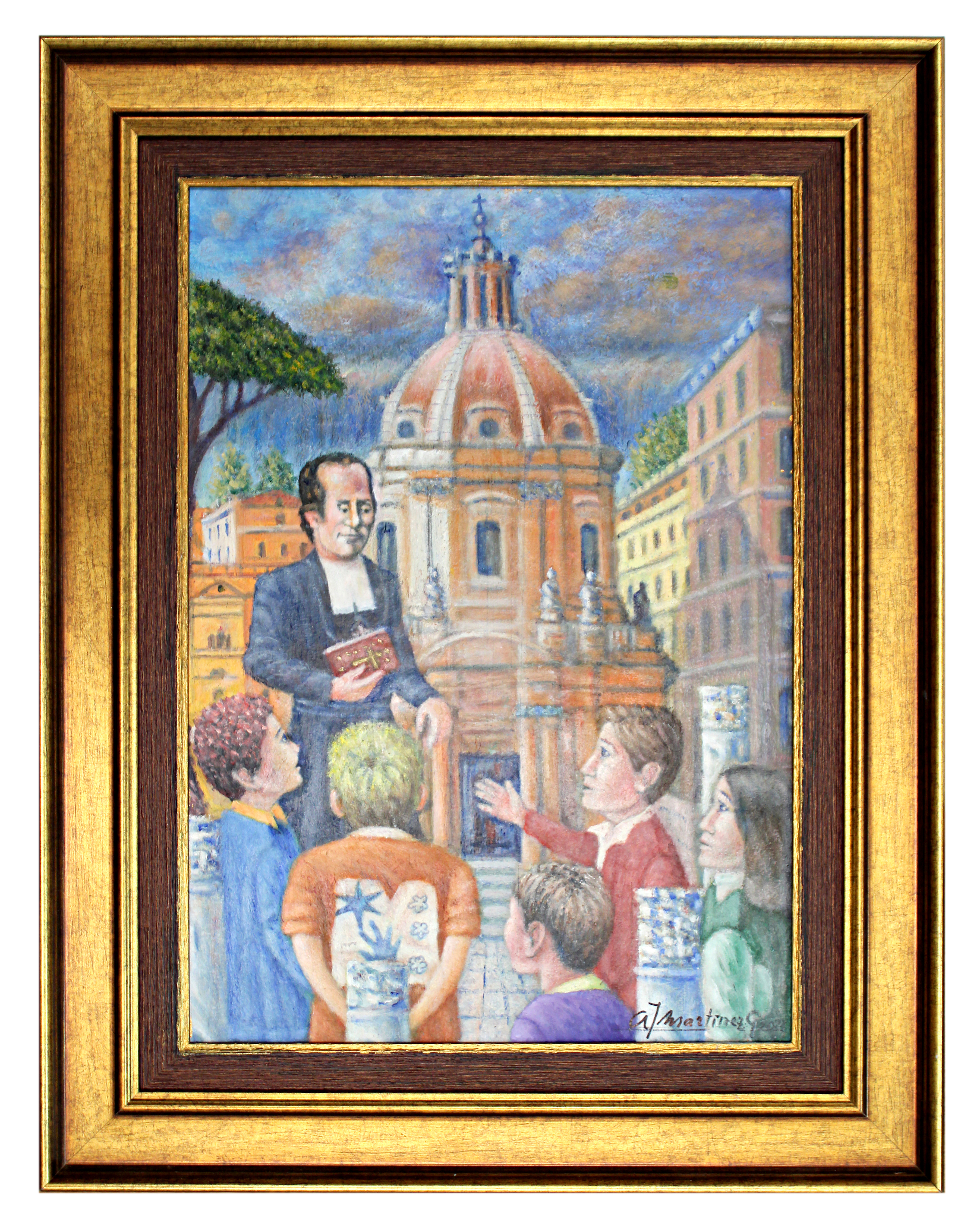Br. François – Drawings by Br. Ángel Ignacio Martínez
1 – Brother Francis at L’Hermitage with Young People
Dimensions: 50 x 35 cm. Vertical
Materials: Oil paper on board
Colors: Oil paint. Harmonious complementary and secondary shades with white
Br. Francis stands in three-quarter left, looking at a group of young people transported in space and time. They are dressed in “Colegio Marista” athletic wear and shirts from various Marist youth organizations. They frame the central character in an open inverted triangle, with the three closest figures in warm tones. The others, in an oval shape, frame the central character from left to right, closing the scene. The building represents L’Hermitage, newly constructed. The River Gier can also be seen.
The sky is imagined, and there are trees from the area, including various firs, cypresses, chestnuts, and river trees of various colors. There are also bushes with flowers, roses, and other garden plants. The background landscape represents the French countryside, which fades into the horizon. The season is summer-autumn. At this time, Impressionism in France is in fashion, despite criticism from the classics. This painting is influenced by Camille Pissarro, Claude Monet, and Sisley.
2 – Brother Francis in his Garden at L’Hermitage
Dimensions: 50 x 32 cm. Vertical
Materials: Oil paper on board
Colors: Oil. Matched and secondary shades with white
A painting of Br. Francis in a summer landscape of a garden-orchard at L’Hermitage. Imagined. He is standing, in three-quarter right position. He is holding a pot and a watering can. Part of a building, L’Hermitage, is visible. Surrounding the building are various colorful trees, firs, thujas, cypresses… The garden is abundant with trees and flowering bushes, roses of various shades, yellow lilies, willows…
There are several written accounts indicating that Br. Francis had a garden where he grew medicinal plants and then made medicine from them.
In the foreground, lower part, medicinal herbs that were used to cure popular illnesses are shown: From left to right: lavender (cures anxiety, poor digestion…), rosemary (is antioxidant, diuretic…), oregano (good for the digestive system, colds and sore throats), mint (relieves digestive disorders, flu and colds), sage (antiseptic and anti-inflammatory). Lower part, on the left: valerian (natural sleep aid), dandelion (prevents heart diseases, controls diabetes), chamomile (improves the digestive system), mint, calendula (antiseptic, relieves digestive and menstrual problems).
This painting is influenced by Camille Pissarro, Claude Monet, and Sisley.
3 – Brother Francis Making Medicine with Plants
Dimensions: 50 x 32 cm. Vertical
Materials: Oil paper on board
Colors: Oil. Complementary muted and secondary with white
Painting of an interior scene featuring Brother Francis three-quarters right, holding two bottles and handling liquids to make medicine. Imagined.
Light from the left side; window and front light from another window.
Typical elements of a 19th century pharmacy can be seen, including bottles, flasks, jugs, bowls, a barrel, an oil lamp, a library and cabinets for storage. There is also a natural plant in the window and another, now dry, on the wall.
In the foreground, there is a table with accessories, various bottles, jars with products to make chamomile, valerian and lime flower, an open reference book and other items.
In writings about Brother Francis, we find many testimonies related to this topic; “A branch that will never cease to fascinate him will be pharmacy. He learns to make remedies; this will allow him to practice as a nurse for much of his life. A volume of his, 848 pages, is preserved where he has recorded the names of many diseases, their diagnosis and treatment: an impressive collection that can allow a researcher to understand the science of the time. The medicine of the time is not smooth: it sought effectiveness. The nurse gradually perfects himself, makes ointments and even a drink made from nine plants mixed with brandy.” (Brother Gabriel Michel, A Humble Hero: Brother Francis, 24).
4 – Brother Francis Visiting a Sick Girl
Dimensions: 50 x 32 cm. Vertical
Materials: Oil cardstock on board
Colors: Oil paint. Complimentary hues and secondary colors with white
An imagined painting of a 19th century French room. The main figure is Br. Francis, accompanied by members of a family of orphaned children and their grandmother. The youngest child is sick with cholera. Francis is visiting, bringing some of his remedies. Possible date, 1832.
History tells us that “in the spring of 1832, something terrifying would trigger a major crisis that would shake the foundations of all France. That bacterial catastrophe had a proper name and was known as cholera” (Wikipedia).
The room is a combined bedroom and kitchen. The elements are typical, pantry, table and kitchen utensils, oil lamp, fireplace… The bed stands out, a license taken from Van Gogh’s painting “The Room” drawn and painted according to the scene.
Br. Gabriel Michel refers to the cholera outbreak of 1832 in France: “To heal the cholera patient, it is necessary to warm him up both externally and internally, surround him with bricks heated in the oven, rub him with nettles, pass a board as hot as possible over his body. After he has vomited, he should drink a glass of brandy to which a dozen well-crushed pepper grains have been added.” (Br. Gabriel Michel, A Humble Hero: Brother Francis, 24)
5 – Brothers Francis and Louis-Marie Arrive in Rome (11-02-1858)
Dimensions: 50 x 32 cm. Vertical
Materials: Oil paper on board
Colors: Oil paint. Complementary and secondary shades with white
An imagined painting that depicts Brs. Francis and Louis-Marie shortly after arriving in Rome. The painting also features common street people of Rome, couples, individuals, a mother and child with a basket, singing children and a priest in the distance. The sky is also depicted.
“Accompanied by Brother Louis-Marie, he left Saint-Genis-Laval on February 6, 1858. They take the express to Marseille where they arrive at 8 in the morning and on the 10th they boarded a ship heading to Civitavecchia. From there they headed to Rome where they arrived on the 11th at 2 in the morning” (Br. Gabriel Michel, A Humble Hero: Brother Francisco, 39).
In terms of buildings, in the background, the Church of the Holy Name of Mary and the Trajan Column can be seen. We are in the Forum of Trajan. We move to the Square of the 12 Apostles, in the Trevi District where in the background we can see the Valentini Palace, where they stayed (the Marist Fathers had rented rooms there). On the right, a building and palace. On the left, the Church of the Twelve Apostles and the ancient Colonna Palace.
Note: The idea of this square is taken from ancient engravings. Today it is greatly modified.
6 – Br. Francis Walking in the Forum Greeted by Young People
Dimensions: 45 x 32 cm. Vertical
Materials: Oil paper on board
Colors: Oil. Complimentary hues and secondary tones with white
This imagined painting depicts Br. Francis strolling in the Forum of Trajan and being greeted from a distance by young people transported in space and time. One is wearing a shirt from the Marist group “Marcha.” In the background is the Church of the Holy Name of Mary with a sky and Roman pine on the left. On the right are buildings in Rome. The columns, starting from the left, frame the central figure of Br. Francis, who, starting from the left and following an imaginary line, surrounds the group in an elliptical shape in the vertical direction.
“The Church of Holy Name of Mary, located in the Forum of Trajan, was the most visited by Francis during his stay in Rome. He visited it on 36 different days. It is difficult to know the reason for this preference since no explicit indication appears in his diary… But we can assume that one of the reasons is practicality, since it is located close to his residence in the Valentini Palace (H. Antonio Martínez Estaún, Folleto Romeros con el Hermano Francisco. Ruta mariana 1. 2019-20, 6).”
7 – Br. Francis with Young People at Santa Maria in Via Lata
Dimensions: 50 x 35 cm. Vertical
Materials: Oil paper on board
Colors: Oil. Complimentary hues and secondary tones with white
Br. Francis in the center, instructing a group of young people wearing Marist group t-shirts in an elliptical formation. The background features a sky and the Church of Santa Maria in Via Lata, as well as a character from the Curia and a mother with a child. According to historical accounts, Br. Francis visited this location at least 5 times, with the first visit being on March 12, on the occasion of his 50th birthday.
The church is also known for hosting the feast of the Visitation of Mary with great solemnity, including a pontifical mass with singing and music by the Pope’s choir. The tradition also states that this church was the residence of Saint Luke, a hospitality for Saint Peter, and a house arrest for Saint Paul of Tarsus while he was in Rome awaiting trial. (H. Antonio Martínez Estaún)
8 – Farewell of Brother Louis-Marie from Rome (04/15/1858)
Dimensions: 46 x 35 cm. Vertical
Materials: Oil Cartulina on panel
Colores: Oil. Harmonious and secondary complements with white
An imagined painting depicting Brothers Francis and Louis-Marie in the foreground, with the Church of the Twelve Apostles in the background. On the right is the ancient palace of the Colonna. The painting is based on an old engraving, and is completed by a noble couple, a man, a mother with a child carrying a bucket, a man and a high-ranking member of the Curia.
Brother Francisco describes the Church of the Twelve Apostles as: “The Church of Santi Apostoli, of Constantinian origin, holds the bodies of St. Philip and James the Less, brother of St. Judas and relative of the Blessed Virgin. (…) It has a closed portico with iron gates and doors, three naves divided by Corinthian columns: tomb of Pope Clement XIV, in a pyramidal shape. Crypt. Small cellar… Well surrounded by a railing” (cited by H. Antonio Martínez Estaún, Marian Route 1 brochure. 2019-20, p. 3).
Brother Louis-Marie returns to France after a second audience on April 15, 1858.








